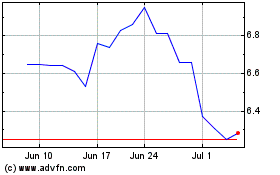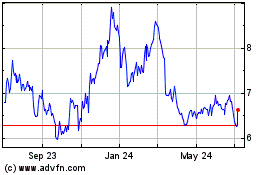By Akane Otani
This article is being republished as part of our daily
reproduction of WSJ.com articles that also appeared in the U.S.
print edition of The Wall Street Journal (July 30, 2018).
The broad U.S. stock market is within 2% of a new high despite
big drops by some of the technology giants that have powered recent
gains, reassuring investors that the nine-year rally remains on
firm footing to continue its run.
For months, analysts and investors have been debating whether a
stock market whose gains have largely been driven by a handful of
technology companies may be subject to a sudden reversal. They have
already witnessed several big selloffs in recent days: Facebook
Inc. wiped out more than $100 billion in market capitalization
Thursday after warning its growth was slowing, while Netflix Inc.
tumbled earlier this month after missing its own forecasts for user
growth by more than a million subscribers. Twitter Inc. and Intel
Corp. slid Friday after posting disappointing earnings.
Yet through much of those shock waves, the broader stock market
has remained resilient. As Facebook suffered its biggest slide as a
public company, dragging other technology stocks down with it, the
S&P 500 slipped just 0.3%. The broad index lost some ground
Friday but eked out a gain for the week and hovered 1.9% away from
its all-time high.
One reason why: While corporate-earnings results have been
uneven for some technology firms, others have continued posting
robust results, with both Alphabet Inc. and Amazon.com Inc. defying
analysts' expectations for yet another quarter. Earnings across the
rest of the stock market have been strong, buoyed by corporate tax
cuts, consumer spending and an economy growing at its fastest pace
in years.
The next big test for the tech sector comes Tuesday, when Apple
Inc. is projected to report double-digit growth in quarterly
earnings and revenue.
Even after adding hundreds of billions of dollars to their
market capitalizations, the five biggest companies in the S&P
500) -- Apple, Amazon, Alphabet, Microsoft Corp. and Facebook --
remain a smaller share of the index than the five biggest during
the lead-up to the 1980s oil glut, the 2000 dot-com bust and the
2008 financial crisis, according to Ned Davis Research.
Taken together, many investors are betting that the stock
market's dependence on a small number of technology giants isn't as
precarious as it seems and that the bull market has the breadth to
continue.
"I would never not want to own some of these names because I
can't imagine what an Amazon or Google are going to come up with
next," said Tom Stringfellow, chief investment officer at Frost
Investment Advisors, which owns a number of the so-called FAANG
stocks: Facebook, Amazon, Apple, Netflix and Google-parent
Alphabet.
To be sure, there are plenty of naysayers who would disagree
with Mr. Stringfellow.
Brendan Erne, director of portfolio implementation at Personal
Capital, has been advising clients to pare back their technology
holdings and raise their exposure to areas of the market that he
considers neglected.
"The fact that investors continue to double down on this crowded
trade is a sign of greed," Mr. Erne said, adding that many seem to
have bought into the idea that "these companies are
infallible."
History has also shown the stock market dropping precipitously
in periods when the weight of the top five stocks in the S&P
500 significantly diverged from the weight of the bottom half of
the index. Before the peak of the dot-com era in March 2000, the
top five S&P 500 stocks made up 18% of the index, more than
double the weight of the bottom half of the index, according to Ned
Davis Research.
Yet the stock market is far less lopsided today, with the top
five S&P 500 stocks making up 14% of the market -- about the
same as the bottom half of the index.
Stock indexes that either exclude or de-emphasize the FAANG
names have also managed to perform well, evidence that areas of the
market that haven't been dominated by technology have still managed
to draw in investors. The Russell 2000 index of
small-capitalization stocks has outpaced the S&P 500's 2018
advance, while the S&P 500 equal-weighted index, which gives
the smallest companies in the index the same weight as the largest
ones, has trailed the S&P 500 by less than 2%.
"There is broader strength outside of just tech," said Jim
Paulsen, chief investment strategist at Leuthold Group.
Much of that has to do with the strength of the economy. Data on
Friday showed the U.S. economy grew in the second quarter at the
fastest pace in nearly four years. The labor market has added jobs
for a record 93 months, while corporate earnings have also shined,
showing companies ranging from industrial conglomerates to oil
producers to department-store owners growing profits with the help
of a potent mix of tax cuts and economic growth.
All that has helped lift stocks across the market and even
revive trades that many investors had left for dead as technology
giants such as Amazon waded further into industries ranging from
health care to retail.
Rising consumer spending, cost-cutting and rewards from shifting
more toward e-commerce have helped stocks such as Macy's Inc. soar
57% this year, outpacing Amazon's 55% gain, while Under Armour Inc.
has jumped 43%, Advance Auto Parts Inc. has added 40% and Kohl's
Corp. has risen 34%. Ten of the 11 sectors in the S&P 500 are
posting gains over the past three months.
"We're in a period of historically low interest rates, a strong
labor market and favorable tech backdrop," said Mr. Erne. Despite
his misgivings about the lofty expectations around large tech
firms, he said those factors are helping him remain cautiously
optimistic.
Write to Akane Otani at akane.otani@wsj.com
(END) Dow Jones Newswires
July 30, 2018 02:47 ET (06:47 GMT)
Copyright (c) 2018 Dow Jones & Company, Inc.
Under Armour (NYSE:UA)
Historical Stock Chart
From Mar 2024 to Apr 2024

Under Armour (NYSE:UA)
Historical Stock Chart
From Apr 2023 to Apr 2024
